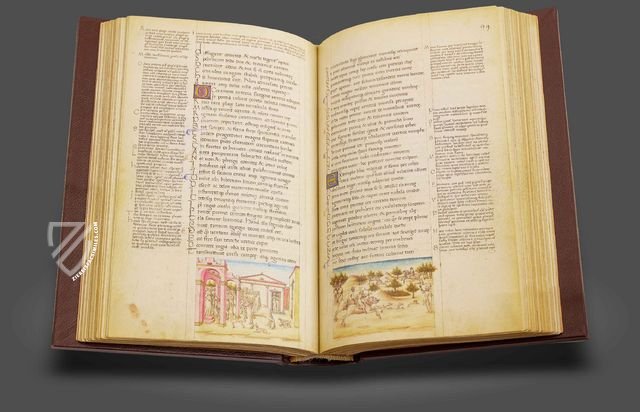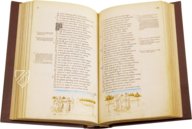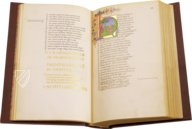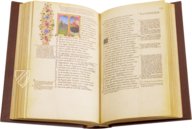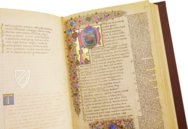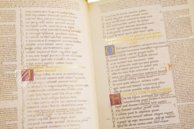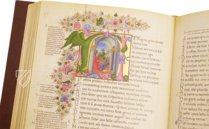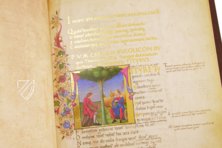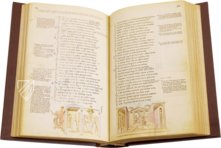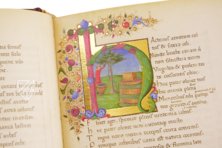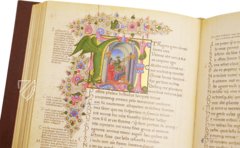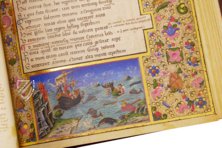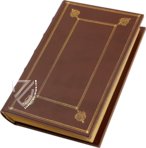Sanudo Virgil
(3,000€ - 7,000€)
The 1st century author Publius Virgilius Maro, better known as Virgil today, was arguably the most important and famous author of literature in the ancient world. His texts have outlasted the centuries and are counted today among the most influential poetry to have ever been written. His three primary works in particular, the Bucolics, the Georgics, and the Aeneid, are of immeasurable significance for world literature and the Appendix Vergiliana contains poems supposedly written by Virgil in his youth. This gorgeous manuscript was made in Ferrara by the Italian master illuminators Guglielmo Giraldi and Giorgio d'Alemagna between 1458 and 1459 and is illustrated by miniatures, historiated initials, and beautiful floral flames.
Sanudo Virgil
The three primary works of the great ancient poet Virgil – namely the Bucolics, Georgics, and the Aeneid – are counted among the most important documents in the history of world literature. The masterful tales revolutionized Latin poetry and shortly after Virgil’s death were already repeatedly transcribed, published, commented on, and reworked. This fine specimen from the Bibliothèque Nationale de France originated from the workshop of Guglielmo Giraldi (ca. 1423 – after 1469) and Giorgio d'Alemagna (ca. 1410/20-1479) in Ferrara between 1458 and 1459 and is adorned with masterful miniatures, initials, and floral borders in the style of the Quattrocento. The work was originally commissioned by Leonardo Sanuto, a Venetian patrician residing in Ferrara at that time.
Classical Latin Bestsellers
The three great works of Virgil are known by the titles Bucolics – the title translates to ‘pastoral poem’ – combining ten eclogues, the Georgics – a didactic poem consisting of four books concerning agriculture and animal husbandry, and the Aeneid epic that is divided into twelve books. The poetic writings were already unified into a Corpus in antiquity. In late antiquity, it was continuously annotated, primarily for use in schools, and was furnished with a comprehensive Vita, primers, and other complementary texts from the most varied of origins. Simultaneously, extremely luxurious editions of the work came to be, in which Virgil’s text was commented on with illustrative pictures.
The Appendix Vergiliana
Juvenilia are works produced by an author during their youth, which, if published at all, usually appears as a retrospective publication after the author has become well known for later works. Virgil’s juvenilia are referred to as the Appendix Vergiliana and consist of a collection of poems that, in its present form, was assembled in Late Antiquity. Although considered to be Virgil’s works during antiquity, modern scholars have deduced that only a couple are actual works by Virgil while the rest are by other authors of the 1st century. Some of the poems may have been attempts by other authors to pass works off under Virgil's name as pseudepigrapha while others may have been mistakenly included in the collection at a later time. Nonetheless, they are fascinating works from the Golden Age of Latin Literature that continue to be studied and debated by scholars to this day.
Antiquity Meets the Renaissance
Thanks to the patronage of the wealthy and sophisticated House of Este, Ferrara grew into a center of manuscript production – humanistic works and transcriptions of rediscovered manuscripts from antiquity in particular. Aside from illustrating the events, the miniatures created by Guglielmo Giraldi and Giorgio d'Alemagna include scenes medieval farmers’ labors and daily life, people in contemporary clothing, but also depictions of soldiers wearing classically styled armor that had also come back into vogue during the 15th century. Some of these miniatures are part of elaborate historiated initials with letters made from dragons, lions, and fish. The figures have the soft, fairytale like quality of the International Gothic style but already possess the naturalism of Renaissance art. A delicate color palette dominated by pinks, blues, greens, and plenty of gold leaf rounds out the presentation of this extraordinarily fine manuscripts.
Codicology
- Alternative Titles
- Virgilio. Eneide, Bucoliche, Georgiche, Appendix Vergiliana
Vergilius Publius Maro: Aeneid, Bucolicon, Georgicon, Appendix
Virgilio Sanudo
Vergil des Lenardo Sanudo - Size / Format
- 231 pages / 26.0 × 16.9 cm
- Origin
- Italy
- Date
- 1458–1459
- Epochs
- Style
- Genre
- Language
- Illustrations
- Numerous miniatures and historiated initals
- Content
- Virgil's Bucolica, Georgica, Aeneis, Appendix Vergiliana
- Patron
- Probably Leonardo Sanuto
- Artist / School
- Leonardo Sanudo (scribe)
Guglielmo Giraldi (illuminator)
Giorgio d'Alemagna (illuminator) - Previous Owners
- Leonardo Sanuto
Marino detto Il Giovane (1466–1536)
Paul Pétau
Sanudo Virgil
The Essential Gestures of the Cook
This bas-de-page miniature shows two people cooking inside of a thatched roof hut with an opening to allow smoke from the open fire to escape. An African woman on the left with ruddy cheeks is seated in a chair wearing a blue dress with a scarf on her head while she stirs a pot suspended from a beam with a large wooden spoon. Straddling a bench on the right, a European man dressed in a pink tunic and tights has his sleeves rolled up as he is mashing something in a bowl.

Sanudo Virgil
Beginning of the Aeneid
“Of arms and the man I sing…” so begins one of the greatest works from the Golden Age of Latin. The opening of the narrative finds the Trojan fleet in the eastern Mediterranean sailing for Italy and the bas-de-page miniature of this lavish page shows them being shipwrecked off the coast of North Africa by Aeolus, King of the Winds, who acts on behalf of the wrathful goddess Juno.
The lovely historiated miniature framed with gold leaf and a pink dragon shows Aeneas in a golden suit of armor reassuring his captains after they have taken shelter on the African coast. Aside from a coat of arms being held up by two muscular nude male angels, the rest of the golden frame consists of colorful flowering tendrils, a songbird, and butterflies.

#1 Virgilio. Bucoliche, Georgiche, Eneide, Appendix Vergiliana
Language: Italian
(3,000€ - 7,000€)
- Treatises / Secular Books
- Apocalypses / Beatus
- Astronomy / Astrology
- Bestiaries
- Bibles / Gospels
- Chronicles / History / Law
- Geography / Maps
- Saints' Lives
- Islam / Oriental
- Judaism / Hebrew
- Single Leaf Collections
- Leonardo da Vinci
- Literature / Poetry
- Liturgical Manuscripts
- Medicine / Botany / Alchemy
- Music
- Mythology / Prophecies
- Psalters
- Other Religious Books
- Games / Hunting
- Private Devotion Books
- Other Genres
- Afghanistan
- Armenia
- Austria
- Belgium
- Belize
- Bosnia and Herzegovina
- China
- Colombia
- Costa Rica
- Croatia
- Cyprus
- Czech Republic
- Denmark
- Egypt
- El Salvador
- Ethiopia
- France
- Germany
- Greece
- Guatemala
- Honduras
- Hungary
- India
- Iran
- Iraq
- Israel
- Italy
- Japan
- Jordan
- Kazakhstan
- Kyrgyzstan
- Lebanon
- Liechtenstein
- Luxembourg
- Mexico
- Morocco
- Netherlands
- Palestine
- Panama
- Peru
- Poland
- Portugal
- Romania
- Russia
- Serbia
- Spain
- Sri Lanka
- Sweden
- Switzerland
- Syria
- Tajikistan
- Turkey
- Turkmenistan
- Ukraine
- United Kingdom
- United States
- Uzbekistan
- Vatican City
- A. Oosthoek, van Holkema & Warendorf
- Aboca Museum
- Ajuntament de Valencia
- Akademie Verlag
- Akademische Druck- u. Verlagsanstalt (ADEVA)
- Aldo Ausilio Editore - Bottega d’Erasmo
- Alecto Historical Editions
- Alkuin Verlag
- Almqvist & Wiksell
- Amilcare Pizzi
- Andreas & Andreas Verlagsbuchhandlung
- Archa 90
- Archiv Verlag
- Archivi Edizioni
- Arnold Verlag
- ARS
- Ars Magna
- ArtCodex
- AyN Ediciones
- Azimuth Editions
- Badenia Verlag
- Bärenreiter-Verlag
- Belser Verlag
- Belser Verlag / WK Wertkontor
- Benziger Verlag
- Bernardinum Wydawnictwo
- BiblioGemma
- Biblioteca Apostolica Vaticana (Vaticanstadt, Vaticanstadt)
- Bibliotheca Palatina Faksimile Verlag
- Bibliotheca Rara
- Boydell & Brewer
- Bramante Edizioni
- Bredius Genootschap
- Brepols Publishers
- British Library
- C. Weckesser
- Caixa Catalunya
- Canesi
- CAPSA, Ars Scriptoria
- Caratzas Brothers, Publishers
- Carus Verlag
- Casamassima Libri
- Centrum Cartographie Verlag GmbH
- Chavane Verlag
- Christian Brandstätter Verlag
- Circulo Cientifico
- Club Bibliófilo Versol
- Club du Livre
- CM Editores
- Collegium Graphicum
- Collezione Apocrifa Da Vinci
- Comissão Nacional para as Comemorações dos Descobrimentos Portugueses
- Coron Verlag
- Corvina
- CTHS
- D. S. Brewer
- Damon
- De Agostini/UTET
- De Nederlandsche Boekhandel
- De Schutter
- Deuschle & Stemmle
- Deutscher Verlag für Kunstwissenschaft
- DIAMM
- Droz
- E. Schreiber Graphische Kunstanstalten
- Ediciones Boreal
- Ediciones Grial
- Ediclube
- Edições Inapa
- Edilan
- Editalia
- Edition Deuschle
- Edition Georg Popp
- Edition Leipzig
- Edition Libri Illustri
- Editiones Reales Sitios S. L.
- Éditions de l'Oiseau Lyre
- Editions Medicina Rara
- Editorial Casariego
- Editorial Mintzoa
- Editrice Antenore
- Editrice Velar
- Edizioni Edison
- Egeria, S.L.
- Eikon Editores
- Electa
- Emery Walker Limited
- Enciclopèdia Catalana
- Eos-Verlag
- Ephesus Publishing
- Ernst Battenberg
- Eugrammia Press
- Extraordinary Editions
- Fackelverlag
- Facsimila Art & Edition
- Facsimile Editions Ltd.
- Facsimilia Art & Edition Ebert KG
- Faksimile Verlag
- Feuermann Verlag
- Folger Shakespeare Library
- Franco Cosimo Panini Editore
- Friedrich Wittig Verlag
- Fundación Hullera Vasco-Leonesa
- G. Braziller
- Gabriele Mazzotta Editore
- Gebr. Mann Verlag
- Gesellschaft für graphische Industrie
- Getty Research Institute
- Giovanni Domenico de Rossi
- Giunti Editore
- Graffiti
- Grafica European Center of Fine Arts
- Guido Pressler
- Guillermo Blazquez
- Gustav Kiepenheuer
- H. N. Abrams
- Harrassowitz
- Harvard University Press
- Helikon
- Hendrickson Publishers
- Henning Oppermann
- Herder Verlag
- Hes & De Graaf Publishers
- Hoepli
- Holbein-Verlag
- Houghton Library
- Hugo Schmidt Verlag
- Idion Verlag
- Il Bulino, edizioni d'arte
- ILte
- Imago
- Insel Verlag
- Insel-Verlag Anton Kippenberger
- Instituto de Estudios Altoaragoneses
- Instituto Nacional de Antropología e Historia
- Istituto dell'Enciclopedia Italiana - Treccani
- Istituto Ellenico di Studi Bizantini e Postbizantini
- Istituto Geografico De Agostini
- Istituto Poligrafico e Zecca dello Stato
- Italarte Art Establishments
- Jan Thorbecke Verlag
- Johnson Reprint Corporation
- Josef Stocker
- Josef Stocker-Schmid
- Jugoslavija
- Karl W. Hiersemann
- Kasper Straube
- Kaydeda Ediciones
- Kindler Verlag / Coron Verlag
- Kodansha International Ltd.
- Konrad Kölbl Verlag
- Kurt Wolff Verlag
- La Liberia dello Stato
- La Linea Editrice
- La Meta Editore
- Lambert Schneider
- Landeskreditbank Baden-Württemberg
- Leo S. Olschki
- Les Incunables
- Liber Artis
- Library of Congress
- Libreria Musicale Italiana
- Lichtdruck
- Lito Immagine Editore
- Lumen Artis
- Lund Humphries
- M. Moleiro Editor
- Maison des Sciences de l'homme et de la société de Poitiers
- Manuscriptum
- Martinus Nijhoff
- Maruzen-Yushodo Co. Ltd.
- MASA
- Massada Publishers
- McGraw-Hill
- Metropolitan Museum of Art
- Militos
- Millennium Liber
- Müller & Schindler
- Nahar - Stavit
- Nahar and Steimatzky
- National Library of Wales
- Neri Pozza
- Nova Charta
- Oceanum Verlag
- Odeon
- Orbis Mediaevalis
- Orbis Pictus
- Österreichische Staatsdruckerei
- Oxford University Press
- Pageant Books
- Parzellers Buchverlag
- Patrimonio Ediciones
- Pattloch Verlag
- PIAF
- Pieper Verlag
- Plon-Nourrit et cie
- Poligrafiche Bolis
- Presses Universitaires de Strasbourg
- Prestel Verlag
- Princeton University Press
- Prisma Verlag
- Priuli & Verlucca, editori
- Pro Sport Verlag
- Propyläen Verlag
- Pytheas Books
- Quaternio Verlag Luzern
- Reales Sitios
- Recht-Verlag
- Reichert Verlag
- Reichsdruckerei
- Reprint Verlag
- Riehn & Reusch
- Roberto Vattori Editore
- Rosenkilde and Bagger
- Roxburghe Club
- Salerno Editrice
- Saltellus Press
- Sandoz
- Sarajevo Svjetlost
- Schöck ArtPrint Kft.
- Schulsinger Brothers
- Scolar Press
- Scrinium
- Scripta Maneant
- Scriptorium
- Shazar
- Siloé, arte y bibliofilia
- SISMEL - Edizioni del Galluzzo
- Sociedad Mexicana de Antropología
- Société des Bibliophiles & Iconophiles de Belgique
- Soncin Publishing
- Sorli Ediciones
- Stainer and Bell
- Studer
- Styria Verlag
- Sumptibus Pragopress
- Szegedi Tudomànyegyetem
- Taberna Libraria
- Tarshish Books
- Taschen
- Tempus Libri
- Testimonio Compañía Editorial
- Thames and Hudson
- The Clear Vue Publishing Partnership Limited
- The Facsimile Codex
- The Folio Society
- The Marquess of Normanby
- The Richard III and Yorkist History Trust
- Tip.Le.Co
- TouchArt
- TREC Publishing House
- TRI Publishing Co.
- Trident Editore
- Tuliba Collection
- Typis Regiae Officinae Polygraphicae
- Union Verlag Berlin
- Universidad de Granada
- University of California Press
- University of Chicago Press
- Urs Graf
- Vallecchi
- Van Wijnen
- VCH, Acta Humaniora
- VDI Verlag
- VEB Deutscher Verlag für Musik
- Verlag Anton Pustet / Andreas Verlag
- Verlag Bibliophile Drucke Josef Stocker
- Verlag der Münchner Drucke
- Verlag für Regionalgeschichte
- Verlag Styria
- Vicent Garcia Editores
- W. Turnowski Ltd.
- W. Turnowsky
- Waanders Printers
- Wiener Mechitharisten-Congregation (Wien, Österreich)
- Wissenschaftliche Buchgesellschaft
- Wissenschaftliche Verlagsgesellschaft
- Wydawnictwo Dolnoslaskie
- Xuntanza Editorial
- Zakład Narodowy
- Zollikofer AG

